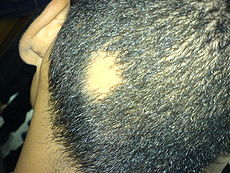
Classification
1. Hair loss from whole scalp more diffusely is known as diffuse alopecia areata.
2. Baldness only in one spot on scalp or dermis is known as alopecia areata monolocularis.
3. Multiple areas of baldness on scalp or dermis is known as alopecia areata multilocularis.
4. Alopecia areata barbae is a condition in which baldness is only seen on the beard.
5. Total loss of hair from the scalp is known as alopecia areata totalis
6. Loss of hair from whole body is alopecia areata universalis which is very rare.
Epidemiology
0.1 to 0.2 percent of the population is affected by alopecia areata. It can occur in both male and female. Initial presentation may occur in late teen ages and progress as the age advances. Persons with immune system disorders like asthma and allergies are affected more than persons who have normal immune system.
Signs and symptoms
• Rapid loss of hair from a particular area of body or from whole body.
• Round or oval shaped area or areas of baldness.
• Normal looking skin under the areas of baldness, but may be slightly painful.
• “Exclamation point appearance” due to hairs becoming narrower close to the base.
• Pitting nails
Diagnosis
Alopecia areata is usually diagnosed based on clinical features.
On inspection using Trichoscopy, area of baldness shows yellow dots or black dots due to hyper-pigmentation.
Biopsy is rarely required for differential diagnosis and may reveal lymphocytic infiltration.
Causes
The exact cause of the disease is still not known. Studies have found a link between the genetic factors and alopecia areata. Persons with one or more family members affected with this disease are more likely to have alopecia areata.
Alopecia areata is thought to be an autoimmune disease. T-cells are found to be accumulated in areas of baldness that probably attacks the hair follicles causing hair fall and prevents re-growth.
It is also associated with emotional distress and pathogens in some cases. It is also found that this disease is associated with the colour of hair. Gray coloured hairs are more affected than black hair.
Treatment
Corticosteroids can control the disease to some extent. However there are no effective treatment to control alopecia areata.
Some medications used to treat alopecia areata are minoxidill, elocon ointment and topical immunotherapy. Topical tacrolomus ointments are also used to suppress hair loss.
Diphenylcyclopropenone may be used to increase the regrowth of hair from areas of baldness.
Prognosis
In some cases hair re-growth occurs in areas of baldness and may become normal within few months to years. These patches may also increase overtime and lead to alopecia totalis or universalis. Effect of this disease is psychological and proper adaptive mechanism is essential in coping with the effects of this disease.
No comments:
Post a Comment